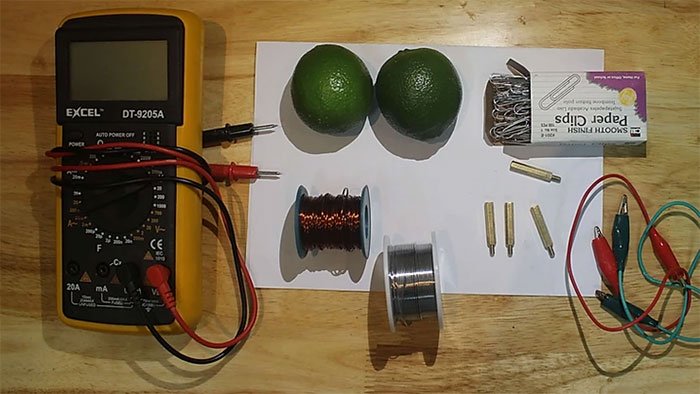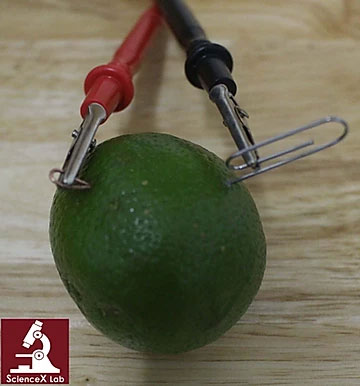Principles and how to make lemon battery
Only with the simple principle that you can generate electricity from lemons.
Power supplies
Electricity that can be sold to the household by the state is alternating current. We also use electricity in the form of DC power sources such as batteries and batteries. Batteries are used as generators for cars and motorcycles, and batteries are compact devices that are very close to the ones we have in watches, TV controls, etc.
But why do we always think about buying from the store when we mention batteries? Can we create our own small DC power source for some daily activities? For example, a night light . We can create electricity similar to batteries in a simple and safe way.
The basic components of a battery
To learn about the phenomenon of electric kinetic energy (i.e. voltage) and the current generated by a lemon, we need some simple materials, as shown in the picture.

Materials used to make lemon batteries.
First plug 2 pieces of wire / piece of metal into the lemon and remember not to touch them. To verify if there is a potential difference between the two metals, connect the two wires to a multi-function electric meter.

First plug 2 pieces of metal wire / piece into the lemon.
What if the two metal wires used were the same (two pieces of copper or two pieces of zinc, two screws)? There will be no voltage appears. Now try with a copper wire and a screw or a copper wire with a paper clip. Is the clock only about 0.8 - 0.9V? So there was a potential difference between the two metals.

If you squeeze lemon juice in a cup and put two different metal wires in it, what happens?
Now, squeeze the juice of lemon juice into a cup, then dip into the cup two metal wires (let them touch the lemon juice and the two metals touch each other). Connect these two metals to the electricity meter again. You may realize that if the two metals are different then continue to create kinetic energy between the two metals.
Explain
Because lemons contain citric acid (an organic acid) , which is considered an electrolyte solution. Furthermore, when a metal is attached to a lemon, either metal or both have a chemical reaction between the acid and the metal. This can cause the metal wires to be charged (excess electrons), resulting in one wire being more negative than the other. When connecting two poles by a wire, the current is formed by the movement of the negative charge from the cathode to the anode

When two different metal rods (eg copper and iron) are immersed in an electrolyte solution (containing ions), and at the same time a reaction occurs at the iron bar, the voltage may appear.
So we can conclude, that to have a battery (electrochemical battery) requires 2 components is a solution of electrolytes and two other intrinsic metals. Based on this, we infer that acid solutions can be replaced with table salt solutions, although the resulting voltage may be smaller.
Can the electricity generated from these lemons be used?
The answer is yes . By connecting the batteries (one battery's cathode to the other's positive pole) or parallel (the cathode connected together, the anode connected to each other) we can create a power source strong enough to make light up a small LED light bulb.
- How to make cool lemon tea to cool the sunny day
- You can use lemon to charge your phone but how much fruit will we need?
- Why should you put a lemon on the bedside?
- The pieces of lemon in the shop, how dirty can they be?
- How to create 1 tablet battery?
- How to choose fresh lemon without poisoning
- Giant lemon
- Why should you put a slice of lemon at the headboard when sleeping?
- Drinking 1 cup of lemon juice is better than a tonic
- Finger Lemon - Lemon is the most expensive salmon egg in the world
- LG launches Flexible Battery Pack for Smartphone
- 14 interesting effects of fresh lemon
 'Barefoot engineer' invents a pipeless pump
'Barefoot engineer' invents a pipeless pump Process of handling dead pigs due to disease
Process of handling dead pigs due to disease Radiometer
Radiometer Warp Engine: Technology brings us closer to the speed of light
Warp Engine: Technology brings us closer to the speed of light Amazing Phenomenon in Space: Why is the International Space Station Rusting?
Amazing Phenomenon in Space: Why is the International Space Station Rusting?  Rhodium – The mystery of the most expensive material in cars
Rhodium – The mystery of the most expensive material in cars  Nickel riddles - A precious but not rare metal is causing the global supply chain to falter
Nickel riddles - A precious but not rare metal is causing the global supply chain to falter  Successfully developing metamorphic metal, the future of creating T-1000 like in 'Terminator' will not be far away
Successfully developing metamorphic metal, the future of creating T-1000 like in 'Terminator' will not be far away  Robots can recharge themselves by 'eating metal'
Robots can recharge themselves by 'eating metal'  The first liquid metal network was successfully built, the future of 'Terminator' T-1000 is not far away?
The first liquid metal network was successfully built, the future of 'Terminator' T-1000 is not far away? 